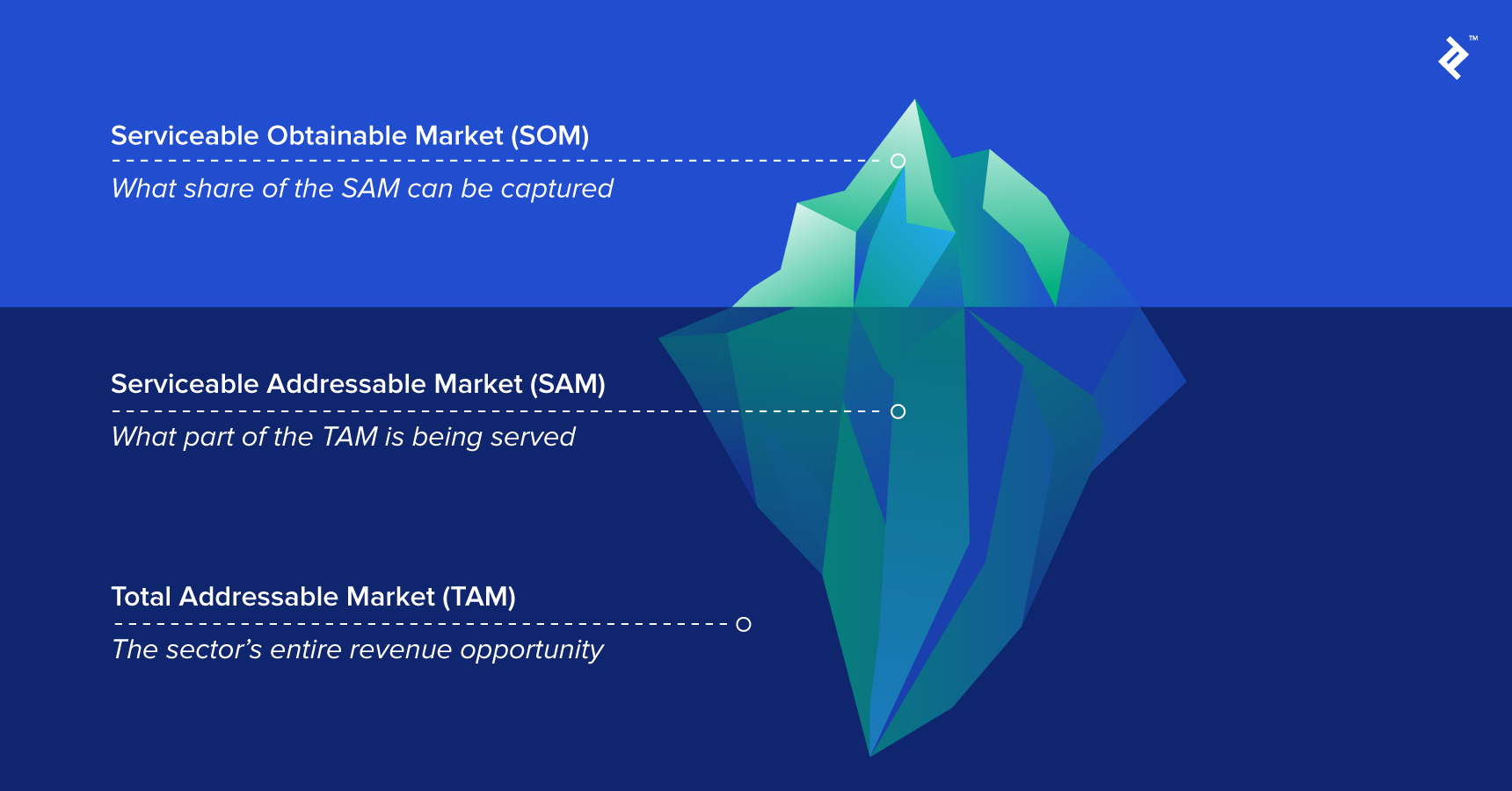Estimating market size is one of the most important tasks that any entrepreneur needs to perform early on in the lifetime of their startup.
In fact, you should estimate market size when you are evaluating any startup idea — before you even start working on it — as this will help you determine if going after a specific market with a product or service you have an idea for is even worth it.
Knowing your market size also lets you determine if you should go through the VC or bootstrapped path. Since most VCs only want to invest in potential unicorns, if being backed by VC is what you want, you should make sure your startup idea has a huge potential market.
What Is TAM?
TAM stands for Total Addressable Market or Total Available Market. Your TAM is the total possible market demand for the product or service you’re selling.
TAM is typically represented by a dollar figure that you determine by estimating the average cost of your product or service and multiplying that by all the people in your total market. In other words, it’s the maximum revenue your company could potentially generate in a specific market if you were able to tap into 100% of the available market.
It’s important to note that most companies are never able to sell their product or service to 100% of the TAM because you would have to have zero competitors in order to do so. Companies with a total monopoly in a specific market are the only ones that are able to earn all the potential revenue from their TAMs.
So, why does calculating your TAM matter for startups if you are unlikely to ever capture all that revenue? Well, it helps you create a value proposition for your business. This helps you determine your company’s overall potential for growth, which is essential when pitching your startup to investors.
What Is SAM?
SAM stands for Serviceable Addressable Market or Serviceable Available Market. Your SAM is a subset of your TAM limited to specific geographic areas that you can reach.
Like TAM, SAM is represented by a dollar figure that represents the total revenue you could receive if everyone you could potentially sell to in a certain geographic area buys your product or service.
For instance, if you are selling a product that you will only sell in California to start out, your SAM would be the total possible revenue available from the number of people in your Total Available Market who live in California.
What Is SOM?
SOM stands for Service Obtainable Market. This is an even smaller subset of your SAM that represents the number of people and revenue you are realistically able to capture.
So, if you are selling your product only in California to start out, your SOM would be the revenue available from a number of people who live in California and visit the certain types of stores that will be carrying your product, and actually buy your product.


How To Calculate Your Market Size
Calculate Your TAM
There are three different ways to calculate your TAM:
Top-Down Approach
The top-down method of calculating TAM is called so because it is shown as an inverted pyramid.
In this approach, you use different industry research to narrow down a large market to your specific TAM. You can get this industry research from secondary parties, such as industry research companies including Gartner and Forrester.
For example, if you are selling human resources software online to anyone in the world, the top of your inverted pyramid would show the number of businesses in the world that use or could use HR software (according to the secondary data you acquire).
After you have the number at the top of the inverted pyramid, you conduct further data analysis to eliminate a certain number of these companies that are unlikely to buy your software. Ultimately, the bottom of the inverted pyramid shows the percentage of the total worldwide market that your business could potentially sell to.
In this example, you might determine from the data that 40% of businesses in the world that could use your HR software already use some kind of HR software from a competitor, which would leave 60% of the total worldwide market as your TAM.
It’s important to note that, while the top-down approach can give you a good general estimate of your TAM, it may be somewhat limited by what data is available to you. For instance, you might not be able to find up-to-date data from the past year or so, in which case your estimate could be inaccurate.
Bottom-Up Approach
The bottom-up approach to calculating your Total Addressable Market tends to be more accurate and reliable than the top-down approach because it uses first-hand market data instead of secondary research.
To calculate your TAM using the bottom-up approach, multiply the total number of potential customers in your industry by the average annual spending on your product or service.
For example, if you are selling wine in New York, first determine how many stores you could potentially sell your wine to. Then, multiply this number by the average cost of the wine you estimate each store would buy every year.
So, let’s say you determine that there are 200 stores who could carry your wine and that each store would buy an average of 50 cases of wine a year, which costs a total of $5,000. In this scenario, the equation for calculating your TAM would be: TAM = 200 x $5,000.
The resulting TAM you get from this equation is $1,000,000, which is the total potential annual revenue you estimate you could earn from your target market.

Value-Theory Approach
The value-theory approach to finding your startup’s Total Addressable Market uses estimates of how much value your customers receive from your product or service and how much they will be willing to pay for that product or service in the future.
This is a more abstract approach than the two above, as it relies more on broad estimates than on analyzing existing data. It usually works best when you are introducing a totally new product to the market or introducing a better version of an existing product to customers.
For example, if you are planning on selling a new type of bicycle brake in bike shops, you would estimate how much more bike shops would be willing to pay for the new brakes compared to other types that they carry. Then, you can use this to calculate the TAM, or the total potential revenue you could earn, based on how many bike shops you could potentially sell your product to.
Calculate Your SAM
Once you have calculated your TAM, you can move on to calculating your SAM. Remember that your SAM is the portion of your TAM that you can theoretically reach based on geographic location.
For instance, if your TAM for your beverage brand is the whole United States, but you only have the infrastructure to serve a few specific states right now, you need to determine how many potential customers are in those states to find your SAM.
Depending on what method you used to calculate your TAM, you could use the same one to find your SAM. For example, if you used the top-down approach and used data about the whole population of the United States, you can now look for data regarding the specific states you plan on targeting right now to find your SAM.
For example, if you estimated that you could eventually sell beverages to 2000 specialty grocery stores across the US to find your TAM, but you can only supply enough for stores on the West Coast to start out, you can now eliminate stores outside of Washington, Oregon, and California. Whatever number of specialty grocery stores you are left with in those three states times the average cost of a sale to them is your SAM.

Calculate Your SOM
Calculating SOM is generally something you do after you already have historical data regarding customers, sales, and revenue. This is because it is an estimate of your actual market size, rather than potential market size.
To calculate SOM, start by dividing your previous year’s revenue by your previous year’s SAM. For example, if your last year’s revenue was $1 million and the SAM was $3 million, your equation would be: $1,000,000 / $3,000,000 = 0.33 (33%).
Next, you multiply the percentage you got by the current year’s SAM. So, if your SAM for this year is $3.5 million, your equation would be: 0.33 x $3,500,000 = $1,155,000. The SOM, or the estimated actual revenue your company is expected to earn this year would be $1,155,000.

How To Calculate Market Value
After you have estimated your market size, you can use it to calculate your market value and plan for growth.
To do this, the first step is estimating market volume, or market potential. This refers to the total amount of potential sales you could make of your product or service within a set period of time.
In order to find your market volume for a specific period, you must calculate what your market penetration rate is.
Market penetration is represented by a percentage that is equal to the portion of a total target market that you have sold your product or service to one or more times within the specific period of time.
To calculate your market penetration rate, use the following equation: penetration rate = (number of customers sold to / market size) x 100.
So, if you have sold to 1000 customers out of a target market with a size of 2000, the equation would be: (1000 / 2000) x 100 = 50%. In other words, your current market penetration rate is 50%.
Now, to calculate your market value, multiply your number of sales by the average value of a sale to each customer.
Once you get both your market penetration and your market value, you can better understand the potential for increasing revenue as you scale and grow your business over specific periods of time.

Example of Calculating Market Value
Let’s say you are selling a rideshare service in Seattle and you determined that your maximum target market size in the city is 500,000 people.
In the first month of operation, let’s say you sold rides to 30,000 people at an average cost of $12 per ride.
To find your market penetration, the equation would look like this: (30,000 / 500,000) x 100 = 6%. So, your current market penetration rate is 6%.
Now, to get your market value, you would multiply your number of sales by the average cost: 30,000 x $12 = $360,000.
So, now you know that your current market value is $360,000 and you have penetrated just 6% of your target market in one month of operation. This means that, if you are able to double your market penetration in your second month of operation, you could increase your market value to $720,000.
Wrapping Up on Market Size Calculation
Calculating your market size is important for startups because it helps you evaluate the potential for growth, which in turn gives you an idea of whether your business idea is worth it (and whether investors will want to back you),
However, you should continuously calculate and update your market sizes as you grow your business and tap into new target markets. You can use these calculations to help plan your growth and determine where to focus different marketing and sales efforts for maximum revenue.
When you are just brainstorming startup ideas or launching a new startup, begin by calculating your TAM and SAM, which you can do by analyzing data that is already available to you from other sources. After you have been operating and actually selling your product or service, you can use past sales data to calculate your SOM.
All of these market size estimates can be used when you pitch your startup to investors during different funding rounds.
You can also use your market size estimates to calculate market penetration and market value, which are very helpful for business planning and can help inform important decisions you make as you expand your company into other markets.






